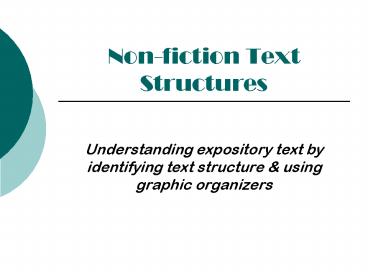Nonfiction Text Structures PowerPoint PPT Presentation
1 / 17
Title: Nonfiction Text Structures
1
Non-fiction Text Structures
- Understanding expository text by identifying text
structure using graphic organizers
2
WHY learn text structure?
- This strategy is NOT a replacement for SQ3R. You
should still survey text, create questions, read
mark text carefully, and recite/review
information. - Text structures show you the PLAN an author had
for writing kind of like a map that they created
to lead you to their main point. - Using SQ3R AND understanding text structures will
help you figure out WHY an author wrote something.
3
Sequence/Chronological Structure
- Used to show steps in a process or to tell a
series of events - This is most similar to narrative text
- Key words first, second, last, next, then,
finally - Graphic organizer timeline or flowchart
4
Example of sequence/chronological structure
- (1) When Arnod Paole was attacked by a vampire,
he knew what to do to save his soul. He tracked
the creature to its grave and thrust a stake
through its heart, smearing his own body with the
blood. He would often retell the tale to fellow
villagers, drawing gasps of admiration. Life
carried on as normal, that is until Paole fell
and broke his neck. He was buried at the local
graveyard where he seemed to come back to life.
5
Sequence/Chronological Structure Graphic
Organizer Timeline
Arnod Paole was attacked by a vampire
6
Description/Definition Structure
- Author describes unique features or
characteristics of a thing, animal, place, etc. - This structure is common for introducing new
material. - Key words for example, for instance, in
addition, also - Graphic organizer web
7
Example of description/definition
- (5) When asked what they thought a vampire would
look like, people describe the creature as it was
portrayed in the 1897 novel 'Dracula' written by
Bram Stoker. They depict him as a handsome
aristocrat, a wealthy man who is charming
attractive. He sleeps by day in his coffin, then
awakes at night to take flight and find his
unsuspecting victims whose blood he drinks.
Despite these super-human powers, the vampire is
scared of crosses, garlic and light.
8
Description/Definition StructureGraphic
Organizer Web
Characteristic
Characteristic
Topic
Vampires
Characteristic
Characteristic
9
Compare/Contrast Structure
- Author explains similarities differences
between two items, people, places, etc. - Key words similar to, likewise
- on the other hand, in contrast, etc.
- Graphic Organizer T-chart or Venn diagram
10
Example of compare/contrast structure
- (6) There have developed over the years two
different types of vampire. The folklore vampire
is the one that seems to have been around for
longest. These creatures have been reported for
centuries by villages who claim to have been
victimized by the vampires. The big difference
between the two types of vampire are, the
folklore vampire would never stray far from his
village. He would not live in a coffin, but would
occupy the graveyard and select a local victim.
The media version is depicted as most people
understand the word 'vampire' to mean a wealthy
man with special powers, rising from a coffin
each night to find victims. This kind of
depiction has been the result of numerous films
and novels.
11
Compare/Contract StructureGraphic Organizer
T-chart
Topic 1 Folklore Vampire Topic 2 Media Vampire
12
Cause Effect Structure
- Author tells reasons why something happened
(cause) and/or results of something that happened
(effect) - Key words as a result, consequently, therefore,
because - Graphic organizer Cause effect chart
13
Example of cause effect structure
- (7) Today science can fully explain the nature
of a decomposing body. It is now known that after
death the body begins to decay. This process
includes the body swelling to a size the person
would never reach in life. The body as it
decomposes would produce gases. To a person two
hundred years ago these effects caused them to
believe that the body was actually producing gas
and the person was breaking wind. The swelling
was seen as a confirmation of the bodys healthy
state.
14
Cause Effect StructureGraphic Organizer
Cause Effect Chart
Effect
Cause
Body begins to decay
Effect
15
Problem/Solution Structure
- Author presents a problem a possible solution
or solutions - Problem/Solution is similar to cause (problem)
effect (solution) also resembles sequence of
events since solution may be carried out in steps - Graphic Organizer flow chart
16
Example of problem/solution structure
- (8) The main method of destroying the body they
believed to be a vampire was to drive a stake
through its heart. This would then cause the
bodys gases to escape causing the a sound of
breaking wind, and in some cases, a groan. If
they suspected that the vampire was still alive,
they would cut the heart from the body and burn
both body and heart separately.
17
Problem/Solution StructureGraphic Organizer
Flow Chart
Dead person is believed to be a vampire

